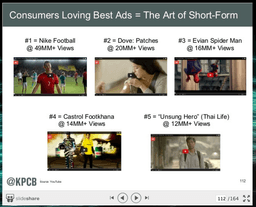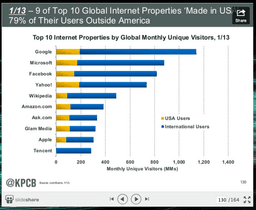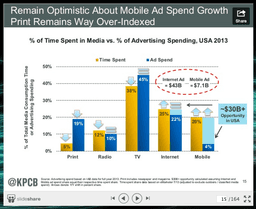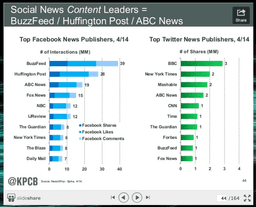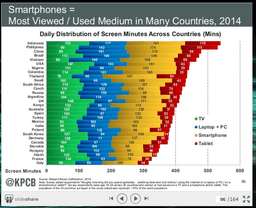Pilot’s top marketing communications lessons from KPCB’s Internet Trends 2014
Silicon Valley venture capitalist firm KPCB released its Internet Trends 2014 report last week – all 164 slides of it. You can view the full report here, but we’ve pulled out five key facts that offer lessons for marketing communications agencies and brands that can be applied right now. Have questions about other slides in the report? Feel free to send us a note or comment below.
#1 Videos and easily digestible, shareable content rule
Videos take brand awareness to a new level, and many companies have become front-runners in brand loyalty and reasserted their positioning directly through success on YouTube. Videos embedded with relevant links and meta-data that is commented on and shared across various platforms can do more for a brand’s web presence than even the most expertly-designed website. But if you want to succeed using videos, you’ll need an appropriate dedicated budget for content creation, development and marketing.
#2 Brands and agencies need marketers that understand localization
Canada and the U.S. may have some of the biggest power houses when it comes to tech companies, but the majority of users are outside of North America – and that number is growing. While an online company has the flexibility to gain global reach in days, marketers and agencies working on behalf of these brands need to understand the global audience, where its coming from, and how it communicates. Localization – the ability to segment audiences, target them geographically by language, culture, or other relevant factors – allows brands to strategically stay true to their positioning and avoid mariginalizing deep pockets of potential users around the world.
#3 Go mobile: print and TV aren’t what they used to be
Print advertising presents the biggest discrepancy between how much brands and agencies pay to advertise versus how much media consumption they receive, with both spend and consumption time dropping again this year. Similarly, TV advertising does not return an adequate amount of airtime to make it worthwhile. And, with the rise of on-demand streaming services, TV’s media consumption time is falling. Mobile and Internet represent growing fields with plenty of opportunity – bidding platforms and ad spend required in exchange for time viewed remains favourable and is rising.
#4 Know which publishers perform well on which networks
It may seem like common sense that publishers made up of aggregated content – sites such as Buzzfeed or the Huffington Post – lead on community-oriented networks like Facebook. Likewise, news sources that are more journalistic and editorial, such as the BBC and the New York Times, lead consumption on Twitter, a platform where the instant feed promotes up-to-the-minute news consumption.
But this difference makes it vital for brands to understand what action they want their audience to perform before publishing on any given platform, or spending time and resources on media relations. A strategic approach that envisions the strategy from beginning to end, with a brand’s goals in mind, is vital.
#5 Choose your platform and reformat accordingly
As the price of hardware decreases, the penetration rate of smartphones and tablets is growing worldwide, especially in developing countries. Already, smartphones are the most viewed medium in many countries. With a rising middle class in much of the developing world, brands may want to target international audiences. But careful attention must always be devoted to choosing the right platform and format content. As audiences expect friendlier, more intuitive user interface design and experience, repackaging the same content or functionality across various platforms without a coherent strategy can alienate potential customers and decrease your brand reach.
